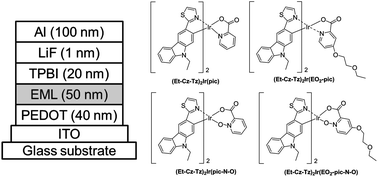A new series of highly efficient phosphorescent Ir(III) complexes, which have potential applications in solution processable phosphorescent organic light-emitting diodes (PhOLEDs), were synthesized and their photophysical, electrochemical, and electroluminescent (EL) properties were investigated. The Ir(III) complexes, including (Et-Cz–Tz)2Ir(pic), (Et-Cz–Tz)2Ir(pic-N-O), (Et-Cz–Tz)2Ir(EO2–pic), and (Et-Cz–Tz)2Ir(EO2–pic-N-O), are comprised of linked N-ethylcarbazole (Et-Cz) and thiazole (Tz) units as the main ligand (Et-Cz–Tz) and picolinic acid (pic) and picolinic acid N-oxide (pic-N-O) as ancillary ligands. In addition, some of the Ir(III) complexes contain an ethylene oxide solubilizing group attached to the ancillary ligands via a tandem reaction. High performance, solution processable PhOLEDs, fabricated using (Et-Cz–Tz)2Ir(EO2–pic), were observed to have a maximum external quantum efficiency of 6.08% and a luminance efficiency of 10.98 cd A−1. This is the first report on the use of EO2–pic and EO2–pic-N-O ancillary ligands for the synthesis of solution processable Ir(III) complexes via a tandem reaction. The performances of the PhOLEDs based on these Ir(III) complexes correlate well with the theoretical properties predicted by using density functional theory calculations.

You have access to this article
 Please wait while we load your content...
Something went wrong. Try again?
Please wait while we load your content...
Something went wrong. Try again?


 Please wait while we load your content...
Please wait while we load your content...